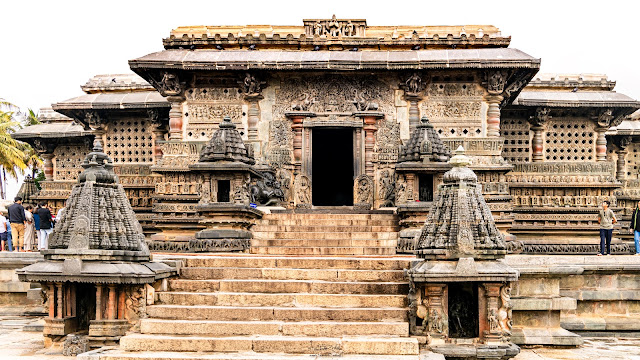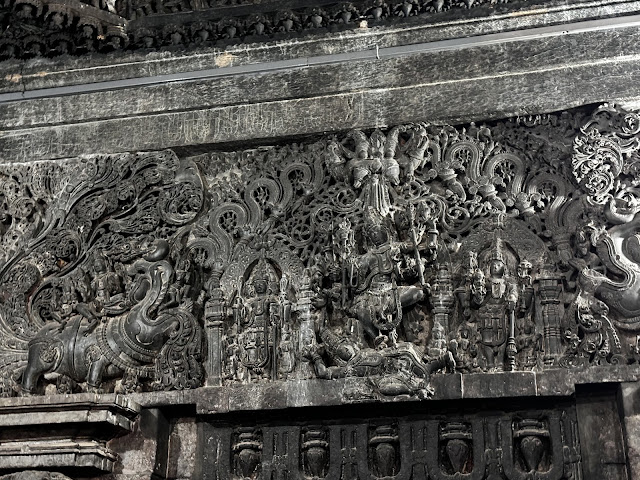Splendor of HOYSALA
Belur - Halibedu - Somnathpura
(June 28 - June 30, 2024)
 |
| Runa & I at Belur (Karnataka) |
No trip to Karnataka is complete without a visit to some of the grand temples of the royal kingdoms that ruled this part of the Deccan. Woven in this intricacy of temples and its astounding architecture conveys the importance of literature, arts and faith.
 |
| Belur - The carvings on the roof in front of the garbagriha |
All of these took shape primarily during the medieval historical period of Karnataka, i.e. 300AD - 1550 AD.
In August 2021, Runa and I visited Hampi, the capital of the Vijayanagara Empire (1336 AD—1565 AD). Check out the updates on Facebook (https://www.facebook.com/profile/100001212159239/search/?q=HAMPI). During the same trip, we also made it a point to visit the cave temples of Badami, which are essential examples of Indian rock-cut architecture and the royal commemoration and coronation temples at Pattadakal. The Badami-Chalukya architecture style influenced many of the temples that came up in the region after their rule ended.
 |
| We visited the remnants of the 15th century Vijayanagara Empire @ Vithala Temple Complex (Hampi) in 2021 Facebook (https://www.facebook.com/profile/100001212159239/search/?q=HAMPI) |
Even before we left Kolkata, visiting the UNESCO World Heritage temples of the Hoysala Kingdom was at the top of our bucket list. Within a week of arriving, we set off for Belur, the former capital of the Hoysala Kingdom. In this episode, we share the awe and wonder of these incredible structures, once bustling temples that showcase the richness of knowledge, art, and craftsmanship.
The understanding of geology, particularly the characteristics of sandstone rocks that allowed for intricate carvings depicting magnificent scenes from Indian mythology, highlights the competence and capability of the artisans. These skilled craftsmen created stunning works without the aid of complex machines, demonstrating their unparalleled mastery.
In this episode, we delve into the essential elements of history and share the captivating images we managed. We aim to entice you, the reader, to visit this marvel of human brilliance carved in stone. During our visit, we visited three temples, all of which have been recognised as World Heritage sites by UNESCO: Belur, Halibedu, and Somnathpura. All the temples are very typical Hoysala structures and thus have a lot of commonality.
Brief - Hoysala Kingdom & Temple Architecture:
The Hoysala Kingdom was a Kannadiga power originating from the MALNAD region that ruled most of what is now Karnataka between the 10th and 14th centuries. Belur was the capital of the Hoysalas initially; later, it moved to Halebidu. The Hoysala era (1026 AD - 1343 AD) was an illustrious period in the development of South Indian art, culture, architecture, and religion. The empire is remembered today primarily for Hoysala architecture; 100 surviving temples are scattered across Karnataka.
A cuboid cell, the garbha griha (sanctum sanctorum) houses a centrally placed murti (enshrined icon) on a pitha (pedestal). The shikhara (superstructure) rises over the garbha griha. Together with the sanctum sanctorium, they form a temple's vimana (or mulaprasada). A ribbed stone, amalaka, is placed atop the shikhara with a kalash at its final. An intermediate antarala (vestibule) joins the garbha griha to an expansive pillared mandapa (porch) in front, chiefly facing east (or north). The temple may be approached via entrances with gigantic gopurams (ornate entrance towers) towering over each doorway. Several minor shrines and outbuildings often abound in the prakaram (temple courtyard).
- [Source https://www.worldhistory.org/article/898/hoysala-architecture/]
The military conquests of Vishnuvardhan (1108 CE – 1152 AD) against the neighbouring Chola Empire was commemorated with the construction of the Chennakesava temple (1117 CE) in Belur to celebrate this victory.
Belur - Chennakesava Temple Complex
 |
| Chennakashavaya Temple - Belur |
This is a temple with one shrine. Regrettably, the shikhara has been lost to the ravages of time. The garbha griha houses an enshrined image of Vishnu. The temple is remarkable for its architecture, sculptures, reliefs,
friezes as well its iconography, inscriptions and history. The temple
artwork depicts scenes of secular life in the 12th century, dancers and
musicians, as well as a pictorial narration of Hindu texts such as the Ramayana, the Mahabharata and the Puranas through numerous friezes.
The whole temple, built on a grand scale, follows the general pattern of Hoysala architecture. It has an east–west orientation set on a jagati.
 |
| Belur Temple front entrance |
The hall has 60 bays and a shrine measuring 10 m on either side. Under the eave cornice of mandapa (outdoor ritual hall) there are 38 most wonderfully sculpted figures called salabhanjika or madanika (bracket figures).
 |
| Salabhanjika on pillars inside the temple |
 |
| The art work on the exterior walls |
 |
| Enlarged view of the left image intricate art work |
 |
| Belur Temple - garbagriha entrance |
Halebidu
Originally, Halebidu was called Dwarasamudra, which refers to a large water reservoir that was excavated almost three-quarters of a century before the city was selected as the capital of the Hoysala Empire. In this dvikuta (temple with two shrines) Shaiva temple, the two garbha grihas (sanctum sanctorum) are found connected by a mandapa (porch), forming a large open hall. One shrine is dedicated to King Vishnuvardhan, and the other to his Queen Shantala. Two adjunct shrines, one for Nandi (bull) and another for Surya (sun), are also built on the same jagati. The exquisite friezes on temple walls eloquently render stories from Ramayana, Mahabharata and Bhagavata Purana. These reliefs preserve one of the finest achievements of Hoysala artisans and constitute an exhaustive lesson in the symbology of Hindu art.
 |
| Halibedu Temple front view |
 |
| Halibedu Temple left side of the entrance - exquisite carvings on sandstone |
 |
| Halibedu Temple entrance - elegant & meticulous depiction |
 |
| Halibedu Temple carvings on the roof at the entrance of the garbagriha |
 |
| Halibedu temple - carvings at the entrance of the garbagriha |
 | |||
| Carvings at the garbagriha entrance | |

Belur and Halebidu's twin cities were once the Hoysala Empire's crown jewels.

Runa & I in front of Halibedu Temple
Somnathpura
 |
| Chennakeshava Temple - Somnathpura |
We visited the third temple at Somnathpura on July 22, 38 kilometres (24 mi) east of Mysuru city. This Chennakeshava Temple is situated on the banks of River Kaveri. The Kesava temple was severely and repeatedly damaged during the ensuing wars, and every time it was hit, the rulers or caretakers tried to repair it. The repair work is quite evident as you walk around.
 |
| Garbabgriha inside |
 |
| Exterior carvings |
 |
| Somnathpura temple exterior carvings not as elaborate as those seen in Belur & Halibedu |
We leave you with some of the images. Hopefully, this will inspire others to visit and experience these marvellous works of art and engineering in person.
As always ... please feel free to comment and share your thoughts.



Comments